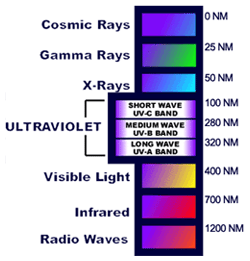Once the pathogenic microbes get a strong foothold, they are very difficult to get back under control without doing damage to the plants. Simply changing the nutrient solution is not usually good enough, by then they have already imbedded themselves on the plants roots causing diseases and viruses. Once that happens, aside from constant care of fungicides and/or H2O2 treatments (that can also do damage to the plants). The only other option is the direct addition of beneficial microbes into the new nutrient solution once it has been changed, in hopes of keeping the pathogenic microbes from out numbering the beneficial ones again. But that wont fix any disease problems that may already exist, just helps keep it from getting too much worse. After that, the plants need to be discarded and the whole system needs to be sanitized to prevent recurrence.
How Ultraviolet Light (UV) Works
 UV light has been used as a water purification system for well over 50 years, so it’s not new technology. Although for hydroponic systems, it can be safely used to kill microorganisms without adding harmful chemicals like chlorine to the nutrient solution. Because the UV light only penetrates the water so far down depending on how strong the light source is. The nutrient solution is run
UV light has been used as a water purification system for well over 50 years, so it’s not new technology. Although for hydroponic systems, it can be safely used to kill microorganisms without adding harmful chemicals like chlorine to the nutrient solution. Because the UV light only penetrates the water so far down depending on how strong the light source is. The nutrient solution is run  through a tube where the water level is sufficient for the light to be able to penetrate all the way through the water. The water then runs through the tube at a flow rate that allows the light to have sufficient time for the UV radiation to kill the organisms. The UV radiation will kill most of the microorganisms directly, or it will sterilizes them. Once a microorganism is sterilized, it cant reproduce and simply dies.
through a tube where the water level is sufficient for the light to be able to penetrate all the way through the water. The water then runs through the tube at a flow rate that allows the light to have sufficient time for the UV radiation to kill the organisms. The UV radiation will kill most of the microorganisms directly, or it will sterilizes them. Once a microorganism is sterilized, it cant reproduce and simply dies.
The UV radiation treatment is safe for people and animals, so don’t worry about glowing nutrient solutions, or glowing plants from radiation. In fact, many people subject themselves to direct UV radiation every day to get a tan at the tanning salon. Once out of the direct UV light (that’s inside the tube) there is no more UV radiation, in which case new microorganism that haven’t been subjected to the light source yet will be able continue to multiply. That’s why the nutrient solution is generally run through the UV light (in the tube) on a continuously flowing basis, keeping new microorganism from being able to multiply.
How Ozone Treatments work
Ozone Treatment is similar to using an air pump to oxygenate the nutrient solution, although Ozone has an extra Oxygen molecule that is highly unstable. That doesn’t mean that it’s dangerous, just that the third molecule dissipates quite quickly (it has a very short half life). The added oxygen molecule makes Ozone a very powerful oxidizing agent, and can result in the elimination of the unwanted pathogens, bacteria and fungi that can cause the diseases and viruses to the plants. With Ozone Treatments, it’s not easy to achieve good reliability due to the short half life, and difficulty in getting good concentrations of Ozone into the nutrient solution. For this reason Ozone Treatments are generally just used in commercial operations.
Ozone treatment systems require an ozone generator, and some of the oxygen from the air that flowers through the generator is converted into Ozone. Then just like an air pump and air stones are used to help oxygenate the nutrient solution, the ozone enriched air (O3) is pumped into the nutrient solution as a stream of bubbles. Contact time between the solution and Ozone bubbles is critical to it’s efficiency, especially due to the very short half life of the (O3) molecules. The Ozone bubbles need to pass through a very deep solution tank usually called an “absorption tower,” this allows the Ozone bubbles to stay in contact with the solution as long as possible for maximum efficiency.
Downsides to using Ultraviolet and Ozone treatments
Both ultraviolet , and Ozone treatments can breakdown some of the iron chelate in the nutrient solution, and that may cause some precipitation of manganese compounds. They also may reduce the “beneficial” micro-flora, which can play a role in suppressing plant disease and viruses. Also if you use any insecticides and/or fungicides in your nutrient solution, UV and Ozone treatments can also breakdown many of the organic compounds in them, once these organic compounds are broken down, some can become toxic to plants. Lastly Ozone can sometimes be damaging to certain plastic parts, mostly for commercially made NFT systems.
Useful Links
Ultraviolet Light Disinfection
Clean Water Supplies for Hydroponics
Hydroponic H2O: Water Quality and Treatment
Ultraviolet Disinfection Technology
